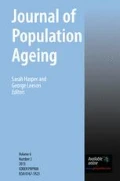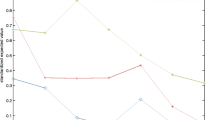Abstract
This paper attempts to elucidate the dynamics and inherent tensions of population aging as it relates to age-period-cohort changes in health status and health care utilization, and attainable system-level transformations. Using the Canadian context, we specifically address three interlocking problems: 1) the paradox of increasing life expectancy with compression of morbidity, concurrent with the rise in the prevalence of chronic illnesses and comorbidity; 2) the complex interactive relationship between baby boomer health status change and temporal improvements in health care efficiency; and 3) the disconnect between health care system efficiency and increasing demands, including patient expectations and end-of-life decision-making. These issues are investigated using interdisciplinary evidence, and applying a set of assumptions to scientific forecasting of modern health care system transformations over the next 20 years, the period in which population aging will peak. Two extreme scenarios positioned at opposite ends of a continuum are advanced that differ on the timing and extensiveness of policy reform versus system-level inertia.
Similar content being viewed by others
References
Alzheimer Society of Canada. (2010). Rising Tide: The Impact of Dementia on Canadian Society. Toronto: Alzheimer Society of Canada.
Angus, D. (1987). Health care costs. In D. Coburn, C. D'Arcy, G. Torrance, & P. New (Eds.), Health and Canadian Society: Sociological Perspectives (2nd ed.). Markham: Fitzhenry & Whiteside.
Bauer, J. C. (2010). Nurse practitioners as an underutilized resource for health reform: evidence-based demonstrations of cost-effectiveness. Journal of the American Academy of Nurse Practitioners, 22, 228–231.
Berkman, L. F., & Kawachi, I. (2000). Social epidemiology. New York: Oxford University Press.
Black, C., Roos, N., Havens, B., & MacWilliam, L. (1995). Rising use of physician services by the elderly’. Canadian Journal on Aging, 14(2), 225–44.
CBC News (2014). ‘Canadian GDP growth to hit 2.6 % in 2014, RBC predicts.’ CBC News. http://www.cbc.ca/news/business/canadian-gdp-growth-to-hit-2-6-in-2014-rbc-predicts-1.2461278. Accessed 29 Jan 2014
Chappell, N., & Hollander, M. (2011a). An evidence-based policy prescription for an aging population’. Healthcare Papers, 11(1), 8–19.
Chappell, N., & Hollander, M. (2011b). The authors respond’. Healthcare Papers, 11(1), 88–91.
cihi (Canadian Institute for Health Information). (2007). Drug Claims by Seniors: An Analysis Focusing on Potentially Inappropriate Medication Use, 2000–2006. Ottawa: cihi.
cihi (Canadian Institute for Health Information). 2010. Health Care in Canada, 2010. (http://secure.cihi.ca/cihiweb/products/HCIC_2010_Web_e.pdf). Accessed 22 Mar 2011.
cihi (Canadian Institute for Health Information). (2011a). Health Care in Canada, 2011: A Focus on Seniors and Aging. Ottawa: cihi.
cihi (Canadian Institute for Health Information). 2011b. National Health Expenditure Trends,1975 to 2011. (http://www.cihi.ca/cihi-ext-portal/internet/en/document/spending+and+health+workforce/spending/release_03nov11). Accessed 30 Nov 2012.
cihi (Canadian Institute for Health Information) (2011c) Health Care Cost Drivers: The Facts. (Ottawa, Ont.: CIHI 2011). https://secure.cihi.ca/free_products/health_care_cost_drivers_the_facts_en.pdf. Accessed 4 Feb 2014.
cihi (Canadian Institute for Health Information) (2013). National Health Expenditure Trends,1975 to 2013—Executive Summary. Ottawa, ON: CIHI; 2013. http://www.cihi.ca/CIHI-ext-portal/pdf/internet/NHEX_EXEC_SUM_2013_EN. Accessed 4 Feb 2014.
cihr (Canadian Institutes of Health Research) (2005). Investing in Canada’s Future: cihr’s Blueprint for Health Research and Innovation. cihr, http://publications.gc.ca/collection/collections/MR21-47-2004E.pdf. Accessed 24 June 2015.
Crimmins, E. (2004). Trends in the health of the elderly’. Annual Review of Public Health, 25, 79–98.
Deyo, R. A. (2002). Cascade effects of medical technology’. Annual Review of Public Health, 23, 23–44.
Easterlin, R. (1991). The economic impact of prospective population changes in advanced industrial countries: A historical perspective’. Journal of Gerontology, Social Sciences, 46(6), S299–S309.
Easterlin, R. (1996). Economic and social implications of demographic patterns. In R. Binstock & L. George (Eds.), Handbook of aging and the social sciences (4th ed., pp. 73–93). San Diego: Academic.
Evans, R., McGrail, K., Morgan, S., Barer, M., & Hertzman, C. (2001). Apocalypse no: Population aging and the future of health care systems. Canadian Journal on Aging, 20(supplement 1), 160–191.
Fries, J. F. (1983). Compression of morbidity’. Milbank Memorial Fund Quarterly, 61, 397–419.
Fries, J. F. (2003). Measuring and monitoring success in compressing morbidity’. Annals of Internal Medicine, 139(5), 455–459. part 2.
Gee, E., & Gutman, G. M. (Eds.). (2000). The overselling of population aging: Apocalyptic demography, intergenerational challenges, and social policy. Don Mills: Oxford University Press.
Health Canada (2012). ‘More effective use of skills’. In Health Human Resources Strategy. http://www.hc-sc.gc.ca/hcs-sss/hhr-rhs/strateg/p2/index-eng.php Accessed 3 Feb 2014.
Hébert, R., Raîche, M., Dubois, M., Gueye, N., Dubuc, N., Tousignant, M., & The PRISMA Group. (2010). Impact of PRISMA, a coordination-type integrated service delivery system for frail older people in Quebec (CANADA): A quasi-experimental design’. Journal of Gerontology: Social Sciences, 65B(1), 107–118.
Hubert, H., Bloch, D., Oehlert, J., & Fries, J. (2002). Lifestyle habits and compression of morbidity’. Journal of Gerontology: Medical Sciences, 57A(6), M347–51.
Hurd, M., Martorell, P., & Langa, K. (2015). Future monetary costs of dementia in the United States under alternative dementia prevalence scenarios. Journal of Population Ageing, 8(1,2), 101–112.
IOM (Institute of Medicine). (2012). Living well with chronic illness: a call for public health action. Washington, DC: The National Academies Pres.
Keefe, J., Vézin, S., Légaré, J., Décarie, Y., & Lefrançoi, G. (2012). Disability and Support Networks of Older Canadians. Research Paper No. 3, Population Change and Lifecourse Strategic Knowledge Cluster. London: Population Studies Centre, UWO.
Kuethe, M.C., Vaessen-Verberne, A.A., Elbers R.G., & Van Aalderen,W. (2013). Nurse versus physician-led care for the management of asthma. Cochrane Database of Systematic Reviews, Issue 2. Art. No.: CD009296. DOI: 10.1002/14651858.CD009296.pub2.
Laszlo, A., & Krippner, S. (1998). ‘Systems Theories: Their Origins, Foundations, and Development. In J. S. Jordan (Ed.), Systems Theories and Apriori Aspects of Perception’ (pp. 47–74). Amsterdam: Elsevier Science.
Légaré, J., & Décarie, Y. (2007). ‘Applying Statistics Canada LifePaths Microsimulations Model to project the health status of Canadian elderly’. Paper presented at the International Microsimulation Association Conference, Vienna, 20 Aug. 2007. Proceedings of the National Academy of Sciences, 103(48), 18374–18379.
Manton, K. (2008). Recent declines in chronic disability in the elderly population: risk factors and future dynamics’. Annual Review of Public Health, 29, 91–113.
Matthews, F., Arthur, A., Barnes, L., Bond, J., Jagger, L., Robinson, L., & Brayne, C. (2013). A two-decade comparison of dementia in individuals aged 65 years and older from three geographical areas of England: The results of the Cognitive Function and Ageing Study I and II. The Lancet, 382(9902), 1405–1412. 26.
Minne, L., Ludikhuize, J., de Jonge, E., de Rooij, S., & Abu-Hanna, A. (2011). Prognostic models for predicting mortality in elderly ICU patients: a systematic review. Intensive Care Medicine, 37(8), 1258–68.
Mor, V. (2005). The compression of morbidity hypothesis: A review of research and prospects for the future’. Journal of the American Geriatrics Society, 53(9: supplement 1), S308–S309.
O’Brien, J. M. (2003). How nurse practitioners obtained provider status: lessons for pharmacists. American Journal of Health-System Pharmacy, 60, 2301–2307.
Parker, M. G., Ahacic, K., & Thorslund, M. (2005). Health changes among Swedish oldest old: Prevalence rates from 1992 and 2002 show increasing health problems. Journal of Gerontology: Medical Sciences, 60A(10), 1351–5.
Rochon, P. A., & Gurwitz, J. H. (1997). Optimising drug treatment for elderly people: the prescribing cascade. BMJ, 315, 1096.
Roos, N., Havens, B., & Black, C. (1993). Living longer but doing worse: Assessing health status in elderly persons at two points in Manitoba, Canada, 1971 and 1983. Social Science and Medicine, 36(3), 273–82.
Statistics Canada (2012). Health Indicator Profile, Annual Estimates, by Age Group and Sex, Canada, Provinces, Territories, Health Regions. Retrieved from CANSIM Tables http://www5.statcan.gc.ca/cansim/a05?lang=eng&id=1050501. Accessed 24 June 2015.
Statistics Canada. (1999a). Health among older adults’. Health Reports, 11(3), 47–61. catalogue no. 82–003.
Statistics Canada. (1999b). Health in mid-life’. Health Reports, 11(3), 35–46. catalogue no. 82–003.
Wister, A. V. (2005). Baby Boomer Health Dynamics: How Are We Aging? Toronto: University of Toronto Press.
Wister, A.V. (2009). ‘We Still Have a Long Way to Go: Patterns of Health and Healthy Lifestyles Across the Generations.” Keynote Address: 19th John Friesen Conference: Staying Active, Staying Healthy: Aging Well in Contemporary Society, Vancouver, BC, April 23–24, 2009.
Wister, A. V. (2011). Population pressures, system-level inertia and healthy aging policy revisited’. Healthcare Papers, 11(1), 8–19.
Wister, A. V., & McPherson, B. (2014). Aging as a Social Process: Canadian Perspectives. Don Mills: Oxford University Press.
Wister, A., Levasseur, M., Griffiths, L., & Fyffe, I. (2015). Multiple morbidity disease burden among older persons: A convergent construct validity study to discriminate between six chronic illness measures, CCHS 2008/09. Biomedical Central Geriatrics, 15(12). doi:10.1186/s12877-015-0001-8.
Wister, A. V., Sixsmith, A., Adams, R., & Kadowaki, L. (2014). Fact Book on Aging in BC and Canada. Vancouver: Gerontology Research Centre.
Wolf, D., MendesdeLeon, C., & Glass, T. A. (2007). Trends in rates of onset of and recovery from disability at older ages: 1982–1994’. Journal of Gerontology: Social Sciences, 62B(1), S3–S10.
Author information
Authors and Affiliations
Corresponding author
Rights and permissions
About this article
Cite this article
Wister, A.V., Speechley, M. Inherent Tensions Between Population Aging and Health Care Systems: What Might the Canadian Health Care System Look Like in Twenty Years?. Population Ageing 8, 227–243 (2015). https://doi.org/10.1007/s12062-015-9123-1
Received:
Accepted:
Published:
Issue Date:
DOI: https://doi.org/10.1007/s12062-015-9123-1




